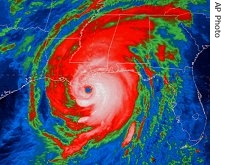 WDSU (New Orleans) has a blog with good up-to-the-minute coverage.
WDSU (New Orleans) has a blog with good up-to-the-minute coverage.
Wikipedia has good coverage round-up and background, although it is not as up-to-the-minute (and beware the troll attacks).
Obviously, my decision to have a Katrina slideshow is affecting loading time of the sidebar, but I will maintain it throughout much of the day.
UPDATE 11:17 a.m. EDT: Katrina downgraded to Category 3; also reports suggest that the storm surge, while extremely high and breaking the NOLA levees at places, is not the 28-foot monster as feared. But even though things look bad in The Big Easy, start looking for the phrases "dodged a bullet" and "bad, but could have been worse" to show up in media reports regarding New Orleans.
One wonders how the Louisiana National Guard will fare in the aftermath of Katrina. Here’s a prescient article from August 1, from an ABC affiliate in Louisiana:
JACKSON BARRACKS — When members of the Louisiana National Guard left for Iraq in October, they took a lot equipment with them. Dozens of high water vehicles, humvees, refuelers and generators are now abroad, and in the event of a major natural disaster that, could be a problem.
"The National Guard needs that equipment back home to support the homeland security mission," said Lt. Colonel Pete Schneider with the LA National Guard.
Col. Schneider says the state has enough equipment to get by, and if Louisiana were to get hit by a major hurricane, the neighboring states of Mississippi, Alabama and Florida have all agreed to help.
"As Governor Bush did for Ivan, after they were hit so many times, he just maxed all of his resources out, he reached out to Louisiana and we sent 200 national guardsmen to help support in recovery efforts," Col. Schneider said.
Members of the Houma-based 256th Infantry will be returning in October, but it could be much longer before the rest of their equipment comes home.
"You’ve got combatant commanders over there who need it they say they need it, they don’t want to lose what they have, and we certainly understand that it’s a matter it’s a matter of us educating that combatant commander, we need it back here as well," Col. Schneider said.
And even if commanders in Iraq release the equipment, getting it home takes months.
"It’s just the process of identifying which equipment we’re bringing home, bringing it down to Kuwait, loading it on ships or aircraft however we’re gonna get it back here and then either railing it in or trucking it in, so we’re talking a significant amount of time before that equipment is back home," Schneider said.

